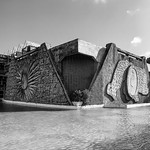A quiet visit to Natal
Though Salvador is a more prominent destination, both nationally and internationally, and also a bigger jumping off point for Africa, Natal, with about 1 million people, is Brazil’s closest city, on the mainland, to both Europe and Africa. The distance from Natal to Chui, in the far south of the country is further than it is to Freetown in Sierra Leone, as is the town of Cruzeiro do Sul, in the far west of Brazil.
Natal’s proximity to Europe and Africa saw the Americans set up a base in town, during the Second World War, which also lead to Brazil being the only Latin American country to send troops overseas during the war.
Earlier, Natal had not benefitted from the sugarcane boom, unlike other major cities in Brazil’s northeast. This, due to the sandy soil being unsuitable for sugarcane cultivation. Instead, the city saw slow economic growth through the raising of cattle, which prefaced the introduction of the typical food of the region, carne de sol, sun dried meat, similar to beef jerky in the US, or biltong in South Africa.
More recently, salt and oil exploration have added to Natal‘s economic benefits. And tourism. Well known for its dunes, you can hop on a camel trek, on imported camels.
The area around Natal was first visited in 1501, but wasn’t settled by Europeans for another few decades. And it was first the French who frequented the area, trading with the Potiguar Indians.
At the end of the 16th century, the Portuguese kicked out the French, and on January 6, 1598, they started building the fort of the three wise men, for the day construction had started.
Natal was founded the next year, on December 25, commemorating the birth of Jesus. Hence, the etymological connection with Kwazulu-Natal, in South Africa, is only through Christianity.
Between 1633 and 1654, the Dutch occupied the area, and briefly renamed the fort, but unlike in Recife, there are no obvious public indicators of the former Dutch presence, except for the recurring ads for Uninassau, a private university borrowing a perception of quality from Dutch royalty.
And, though in Recife there is a kind of odd fondness for its Dutch past, in Natal, the municipal building (prefeitura) is called the Palácio Filipe Camarão, taking its name from a local minor celebrity who fought the Dutch during their incursion in the area.
Camarão, born among the Potiguara Indians, converted to Christianity at around 12, married the next day, and converted his tribal name, Poti, to the Portuguese equivalent, shrimp.
From 1630, until his death in 1648, he fought the Dutch, becoming a well established military commander, eventually leading the right flank in the United Portuguese Army, becoming a Knight Commander of Portugal’s most prestigious military order.
Till the end of his life, he fought against the Dutch forces, which, curiously, until shortly before, had been under a man called Krzysztof Arciszewski, a Pole who had been exiled from his native country, then had first settled in The Hague and after that, had become a vice-governor of Dutch Brazil, and head chief of the Dutch military forces.
Camarão died in the nearby state of Pernambuco, as a consequence of wounds sustained in the Battle of Guararapes, and is buried in Recife.
As an aside, the battle of Guararapes, prefacing the departure of the Dutch from Brazil, is considered, particularly by the army, the birth of the nation of Brazil.
In 2012, Camarão was added to the ‘book of heroes of the fatherland’, which resides at the Pantheon of the Fatherland and Freedom, which is the abstract dove-shaped building at the Three Powers Plaza in Brasilia, next to the National Congress (as well as next to the Supreme Court and the presidential palace).
Now, Natal is known for being more sedate than many other major Brazilian cities. And that’s justified; the city is quiet, the old town, with remnants of late 18th century architecture, is dilapidated, languishing, and in disrepair. Museums are closed, not just due to COVID, public spaces are either shuttered or left to slide into obscurity. Though there still is an occasional suburban train running from the center to two outlying towns, out-of-use tram tracks are easy to find.
Outside of its tourism industry, focussed on its sunny coast, the town gives the impression of having fallen into a long, slow, economic decline, without resources, and perhaps interest, to maintain its cultural heritage.
It’s easy to see parallels with Recife, though they are economically more successful, and with Manaus, with a similarly languishing old town, and for its dilapidated dated architecture, and even with Maputo, with its coastal focus on fishing.
But, the sad state of disrepair of its recent past seems more a choice to shift the city’s focus, as there is plenty of activity that’s directed towards the sea.
One evening, when I got back to my hotel, on the shore, in the north of the city, I came across a troupe of bikers, without leather jackets, and with only a few tattoos, in itself an oddity in Brazil. It was in the early evening, but they were ready to go on parade.
I walked over, sat at a snack bar and ordered a pastel, and then enjoyed the scenery. The crowd soon dispersed, leaving for their collective ride, and I was left with my ‘pastel Nordestino’, a deep-fried envelope of phyllo dough, stuffed with a range of goodies, accompanied by home-made pepper sauce.
It was now very quiet, with the only sound the lapping of the waves on the beach, and the rocks.
How pleasant the sea is.





































